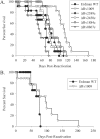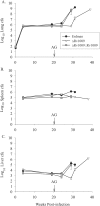Deletion of the Mycobacterium tuberculosis resuscitation-promoting factor Rv1009 gene results in delayed reactivation from chronic tuberculosis
- PMID: 16622237
- PMCID: PMC1459759
- DOI: 10.1128/IAI.74.5.2985-2995.2006
Deletion of the Mycobacterium tuberculosis resuscitation-promoting factor Rv1009 gene results in delayed reactivation from chronic tuberculosis
Abstract
Approximately one-third of the human population is latently infected with Mycobacterium tuberculosis, comprising a critical reservoir for disease reactivation. Despite the importance of latency in maintaining M. tuberculosis in the human population, little is known about the mycobacterial factors that regulate persistence and reactivation. Previous in vitro studies have implicated a family of five related M. tuberculosis proteins, called resuscitation promoting factors (Rpfs), in regulating mycobacterial growth. We studied the in vivo role of M. tuberculosis rpf genes in an established mouse model of M. tuberculosis persistence and reactivation. After an aerosol infection with the M. tuberculosis Erdman wild type (Erdman) or single-deletion rpf mutants to establish chronic infections in mice, reactivation was induced by administration of the nitric oxide (NO) synthase inhibitor aminoguanidine. Of the five rpf deletion mutants tested, one (deltaRv1009) exhibited a delayed reactivation phenotype, manifested by delayed postreactivation growth kinetics and prolonged median survival times among infected animals. Immunophenotypic analysis suggested differences in pulmonary B-cell responses between Erdman- and deltaRv1009-infected mice at advanced stages of reactivation. Analysis of rpf gene expression in the lungs of Erdman-infected mice revealed that relative expression of four of the five rpf-like genes was diminished at late times following reactivation, when bacterial numbers had increased substantially, suggesting that rpf gene expression may be regulated in a growth phase-dependent manner. To our knowledge, deltaRv1009 is the first M. tuberculosis mutant to have a specific defect in reactivation without accompanying growth defects in vitro or during acute infection in vivo.
Figures







References
-
- Barczak, A. K., P. Domenech, H. I. Boshoff, M. B. Reed, C. Manca, G. Kaplan, and C. E. Barry III. 2005. In vivo phenotypic dominance in mouse mixed infections with Mycobacterium tuberculosis clinical isolates. J. Infect. Dis. 192:600-606. - PubMed
-
- Beste, D. J., J. Peters, T. Hooper, C. Avignone-Rossa, M. E. Bushell, and J. McFadden. 2005. Compiling a molecular inventory for Mycobacterium bovis BCG at two growth rates: evidence for growth rate-mediated regulation of ribosome biosynthesis and lipid metabolism. J. Bacteriol. 187:1677-1684. - PMC - PubMed
-
- Bosio, C. M., D. Gardner, and K. L. Elkins. 2000. Infection of B cell-deficient mice with CDC 1551, a clinical isolate of Mycobacterium tuberculosis: delay in dissemination and development of lung pathology. J. Immunol. 164:6417-6425. - PubMed
-
- Cohen-Gonsaud, M., P. Barthe, C. Bagneris, B. Henderson, J. Ward, C. Roumestand, and N. H. Keep. 2005. The structure of a resuscitation-promoting factor domain from Mycobacterium tuberculosis shows homology to lysozymes. Nat. Struct. Biol. 12:270-273. - PubMed
Publication types
MeSH terms
Substances
Grants and funding
LinkOut - more resources
Full Text Sources
Other Literature Sources
Medical
Molecular Biology Databases

